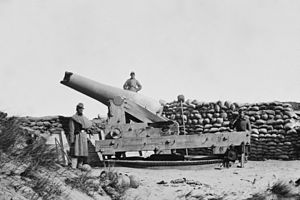First Battle of Fort Fisher
| First Battle of Fort Fisher | |||||||
|---|---|---|---|---|---|---|---|
| Part of the American Civil War | |||||||
 A damaged Confederate gun at Fort Fisher. |
|||||||
|
|||||||
| Belligerents | |||||||
|
|
|
||||||
| Commanders and leaders | |||||||
|
Benjamin Butler David D. Porter |
Braxton Bragg Robert Hoke |
||||||
| Units involved | |||||||
| Expeditionary Corps, Army of the James North Atlantic Blockading Squadron |
Hoke's Division Fort Fisher Garrison |
||||||
| Casualties and losses | |||||||
| 320 | |||||||
The First Battle of Fort Fisher was a naval siege in the American Civil War, when the Union tried to capture the fort guarding Wilmington, North Carolina, the South's last major Atlantic port. Led by Major General Benjamin Butler, it lasted from December 23–27, 1864.
The Union navy first attempted to detonate a ship filled with powder in order to demolish the fort's walls but this failed; the navy then launched a two-day bombardment in order to demolish the fort and compel surrender. On the second day, the Union army started landing troops in order to begin the siege. But Butler got news of enemy reinforcements approaching, and in the worsening weather conditions, he aborted the operation, declaring the fort to be impregnable. To his embarrassment, he was relieved two weeks later by Major General Alfred H. Terry.
After the failed Bermuda Hundred Campaign, Major General Benjamin Butler and his Army of the James were assigned to an amphibious expedition against Fort Fisher. Lieutenant General Ulysses S. Grant had originally designated one of Butler's subordinates, Major General Godfrey Weitzel, to lead the expedition, but Butler, as the commander of the Department of Virginia and North Carolina, demanded that he lead the troops himself and Grant acquiesced. Units for the expedition were selected from the Army of the James and included the 2nd Division of the XXIV Corps and the 3rd Division from the XXV Corps, along with two battalions of heavy artillery and engineers. Colonel Cyrus B. Comstock from Grant's staff went along to serve as chief engineer. The Union naval expedition under Rear Admiral David D. Porter comprised the largest Union fleet of the war, nearly 60 warships along with the transports to carry the army troops.
...
Wikipedia
